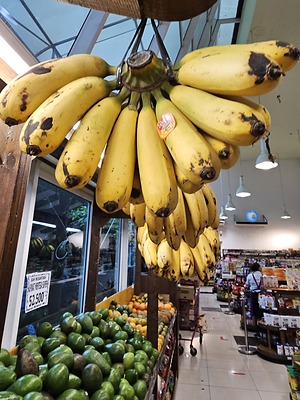


Pisang Susu Bananas
Estimated Inventory, lb : 0
Description/Taste
Pisang Susus are small fruits, averaging 10 to 12 centimeters in length, and have a squat, straight to slightly curved shape. The bananas grow in compact hands of up to 25 fruits, and each stalk can produce 1 to 8 hands. The peel of the fruit is smooth and thin, ripening from green to bright yellow, and can be solid or covered in many small black specks. Underneath the surface, the flesh is ivory to white and has a soft, seedless, smooth, and slightly sticky consistency. Pisang Susus are aromatic and have a fruity, sweet, and honeyed flavor.
Seasons/Availability
Pisang Susus are available year-round in Indonesia.
Current Facts
Pisang Susus, botanically a part of the Musa genus, are small Indonesian bananas belonging to the Musaceae family. There are over 300 varieties of bananas found in Indonesia, and Pisang Susus are a favored cultivar for fresh eating. The name Pisang Susu translates from Indonesian to mean “banana milk,” which is a descriptor used to highlight the fruit’s creamy and seedless, white flesh. In local Indonesian markets, there are three different genotypes of bananas that are generally labeled as Pisang Susu. The two most common types, Pisang Susu Putih and Pisang Susu Hitam are valued for their sweet taste, and the primary distinguishing factor between the two are the black spots on the peel of Pisang Susu Hitam. The third type, Pisang Susu Ternate, is considered very rare and is not typically found in markets due to its sour aftertaste. Regardless of the genotype, Pisang Susus are deemed a table variety and are sold in fresh markets, foraged from the wild, or grown in home gardens.
Nutritional Value
Pisang Susus are an excellent source of vitamin C, an antioxidant that strengthens the immune system, and are a good source of folic acid, which helps to create new red blood cells within the body. The bananas also provide vitamin D to regulate mineral absorption for bone development and contain magnesium, calcium, phosphorus, and fiber.
Applications
Pisang Susus are best suited for fresh applications as their sweet flavor is showcased when consumed straight, out-of-hand. The bananas can be consumed as a breakfast item or afternoon snack, or they can be sliced and mixed into fruit salads. The small fruits are incredibly popular as a fresh children’s snack. Pisang Susus can also be utilized in a variety of sweet applications, including rolled in chocolate, sliced and stirred into coconut milk with brown sugar, or grilled and topped with cheese and chocolate. In Indonesia, pisang goreng, or fried banana, is one of the most popular snacks served through street vendors. Many different bananas can be used, depending on the region, and the fruits are traditionally coated in a thick batter and fried. Pisang goreng is often consumed with tea or coffee and can be served plain, with sauces, or covered in powdered sugar. Pisang Susus pair well with vanilla, chocolate, caramel, fruits such as strawberry, citrus, mango, papaya, and guava, honey, sweet potato, and coconut milk. Whole Pisang Susus will keep up to one week when stored in a cool and dry place away from direct sunlight.
Ethnic/Cultural Info
Indonesian bananas are frequently used in a sweet dessert known as kolak pisang to break the daily fast during Ramadhan's holy month. Indonesia is home to the world’s largest Muslim population, and Ramadhan is considered to be the most sacred month of the year. From sunrise to sunset, Muslims abstain from eating and drinking in an effort to pray and grow in their faith. Once the call to the Maghrib or sunset prayer is sounded in the evening, small snacks and beverages can be consumed to break the fast, known as buka puasa. Kolak pisang is a dessert comprised of coconut milk, sugar, pandan leaves, and banana that can be served hot or cold. The sweet dish is believed to help increase blood sugar levels to help the body adjust from fasting to a full meal. Kolak can be made with many different ingredients, and sweet potatoes are sometimes mixed with bananas for added flavor and texture. In some Indonesian restaurants, kolak pisang is served as an appetizer and is offered for free during Ramadhan.
Geography/History
Pisang Susus are native to Indonesia and have been growing wild since ancient times. The exact history of the variety is unknown, as there are many different varieties of bananas found throughout Indonesia with varying regional names, making it challenging for researchers to created individual records for each. Today Pisang Susus are primarily found in forests or home gardens throughout Indonesia and are not commercially cultivated on a large scale. The small bananas are traditionally told in local markets for fresh consumption.
Recipe Ideas
Recipes that include Pisang Susu Bananas. One








